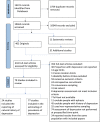Prevalence and natural history of depression after stroke: A systematic review and meta-analysis of observational studies
- PMID: 36976794
- PMCID: PMC10047522
- DOI: 10.1371/journal.pmed.1004200
Prevalence and natural history of depression after stroke: A systematic review and meta-analysis of observational studies
Abstract
Background: Depression is the most frequent psychiatric condition after stroke and is associated with negative health outcomes. We aim to undertake a systematic review and meta-analysis of the prevalence and natural history of depression after stroke.
Methods and findings: Studies published up to 4 November 2022 on Medline, Embase, PsycINFO, and Web of Science Core Collection were searched. We included studies of adults with stroke, where depression was assessed at a prespecified time point. Studies excluding people with aphasia and history of depression are excluded. Critical Appraisal Skills Programme(CASP) cohort study tool was used to assess risk of bias. A total of 77 studies were included in the pooled estimates of the prevalence of poststroke depression (PSD). The overall prevalence of depression was 27% (95% CI 25 to 30). Prevalence of depression was 24% (95% CI 21 to 28) by clinical interview and 29% (95% CI 25 to 32) by rating scales. Twenty-four studies with more than one assessment time point reported the natural history of PSD. Among people who were depressed within 3 months of stroke, 53% (95% CI 47 to 59) experienced persistent depression, while 44% (95% CI 38 to 50) recovered. The incidence of later depression (3 to 12 months after stroke) was 9% (95% CI 7 to 12). The cumulative incidence during 1 year after stroke was 38% (95% CI 33 to 43), and the majority (71% (95% CI 65 to 76)) of depression had onset within 3 months after stroke. The main limitation of the present study is that excluding people in source studies with severe impairments may produce imprecise estimates of the prevalence of PSD.
Conclusions: In this study, we observed that stroke survivors with early-onset depression (within 3 months after stroke) are at high risks for remaining depressed and make up two-thirds of the incident cases during 1 year after stroke. This highlights the need for ongoing clinical monitoring of patients depressed shortly after stroke.
Trial registration: PROSPERO CRD42022314146.
Copyright: © 2023 Liu et al. This is an open access article distributed under the terms of the Creative Commons Attribution License, which permits unrestricted use, distribution, and reproduction in any medium, provided the original author and source are credited.
Conflict of interest statement
I have read the journal’s policy and the authors of this manuscript have the following competing interests:YW is a paid statistical consultant on PLOS Medicine’s statistical board.
Figures







References
-
- Uphoff EP, Newbould L, Walker I, Ashraf N, Chaturvedi S, Kandasamy A, et al.. A systematic review and meta-analysis of the prevalence of common mental disorders in people with non-communicable diseases in Bangladesh, India, and Pakistan. J Glob Health. 2019;9(2):020417. doi: 10.7189/jogh.09.020417 - DOI - PMC - PubMed
Publication types
MeSH terms
Grants and funding
LinkOut - more resources
Full Text Sources
Medical

